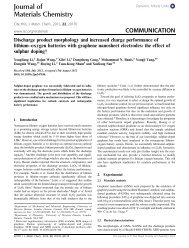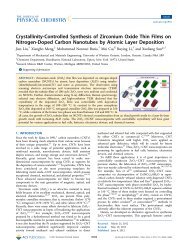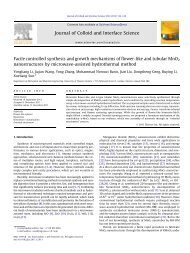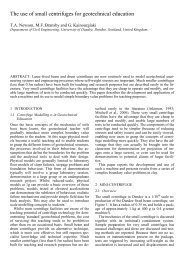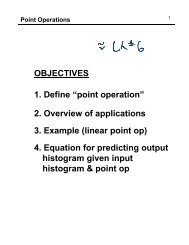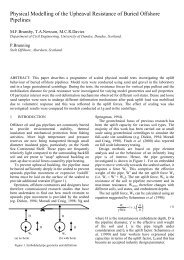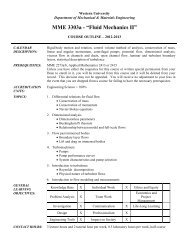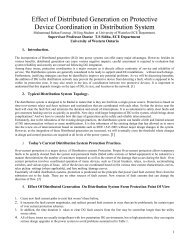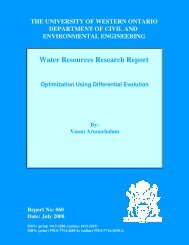Seismic Behavior of Gravel Drains and Compacted Sand Piles using ...
Seismic Behavior of Gravel Drains and Compacted Sand Piles using ...
Seismic Behavior of Gravel Drains and Compacted Sand Piles using ...
Create successful ePaper yourself
Turn your PDF publications into a flip-book with our unique Google optimized e-Paper software.
insitu soil improvement by grouting <strong>and</strong> chemical stabilization <strong>and</strong> <strong>using</strong> <strong>of</strong> relief wells such as gravel or rock drains for<br />
the control <strong>of</strong> undesirable pore water pressure. Although these types <strong>of</strong> mitigation techniques are developed, the<br />
effectiveness <strong>of</strong> these methods are not well defined <strong>and</strong> understood (Das, 1983).<br />
All mitigation techniques which are frequently employed to reduce large deformations <strong>and</strong> subsidence <strong>of</strong> buildings are<br />
based on the following philosophies:<br />
Reducing the build up <strong>of</strong> pore water pressure by means <strong>of</strong> quick drainage <strong>of</strong> water during <strong>and</strong> immediately after the<br />
earthquake.<br />
Improving shear deformability <strong>of</strong> the soil skeleton to prevent large cyclic deformation during the earthquake.<br />
Reinforcing the soil skeleton, which in turn can reduce both shear strain <strong>and</strong> generation <strong>of</strong> excess pore water pressure<br />
<strong>and</strong> increases the soil strength.<br />
One <strong>of</strong> the widely used mitigation methods is <strong>using</strong> gravel drains. The possible benefits <strong>of</strong> gravel drains are densification<br />
<strong>of</strong> surrounding non-cohesive soil, dissipation <strong>of</strong> excess pore water pressure <strong>and</strong> re-distribution <strong>of</strong> earthquake-induced or<br />
pre-existing stresses (due to introduction <strong>of</strong> the stiffer columns). When dealing with non-plastic silty soils, only the third<br />
benefit can be expected primarily to mitigate liquefaction (Baez, 1995). The gravel drain technique is ideally suited for<br />
improving s<strong>of</strong>t silts <strong>and</strong> clays, <strong>and</strong> loose silty s<strong>and</strong>s. The level <strong>of</strong> improvement depends on the soil type, installation<br />
technique, relative spacing <strong>of</strong> the drains, <strong>and</strong> drain diameter. Crushed stones made <strong>of</strong> recycled concrete from torn-down<br />
apartment buildings <strong>and</strong> complexes are suitable alternatives to be used as drain materials (Orense et al., 2003). <strong>Gravel</strong><br />
drains operate by providing preferential drainage paths which enable accumulated pore pressures to dissipate ideally<br />
before the surrounding soil reaches a state <strong>of</strong> initial liquefaction (Brennan <strong>and</strong> Madabhushi, 2002). One <strong>of</strong> the first<br />
studies on gravel drains as liquefaction remediation is that done by Seed <strong>and</strong> Booker (1977). Since this was published,<br />
drains have been subjected to real earthquakes, such as Koshiro-Oki (Sonu et al., 1993), Northridge (Boulanger et al.,<br />
1998) <strong>and</strong> Kobe (Yasuda et al., 1996). Several shortcomings <strong>of</strong> gravel drains have been reported in the literature. A<br />
collected experience suggests that while drains can certainly provide a solution, settlement can still occur to an<br />
unsatisfactory degree (Brennan <strong>and</strong> Madabhushi, 2002).<br />
Regarding aforesaid remarks, in the current study some aspects <strong>of</strong> the effectiveness <strong>of</strong> gravel drains <strong>and</strong> compacted s<strong>and</strong><br />
piles in mitigating excess pore water pressure <strong>and</strong> reducing the subsidence <strong>of</strong> buildings has been studied <strong>using</strong> 1g<br />
shaking table tests <strong>and</strong> following that the experimental results are compared with a numerical method which incorporates<br />
an improved procedure <strong>of</strong> that used by Seed <strong>and</strong> Booker (1977).<br />
PHYSICAL MODELING<br />
A series <strong>of</strong> shaking table tests were conducted on model gravel drains <strong>and</strong> compacted s<strong>and</strong> piles. Figure 1 shows a three<br />
dimensional view <strong>of</strong> the model. Models were constructed in a transparent plexiglass container <strong>of</strong> 180cm long, 45cm wide<br />
<strong>and</strong> 70cm high. The bottom <strong>of</strong> the container was covered by a fine screen mesh so that the saturation process could be<br />
performed by percolating water gradually <strong>and</strong> uniformly from the bottom <strong>of</strong> the soil box.





